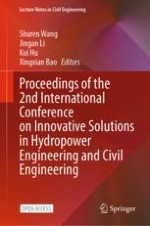1 Instruction
2 Engineering Background and Model
Geotechnical category | γ/(kN m−3) | Cref/kPa | φ/° | K0 | Es/MPa | E50/MPa | Eur/MPa |
|---|---|---|---|---|---|---|---|
② brown-gray silty clay | 18.2 | 20 | 17.5 | 0.47 | 9.7 | 9.7 | 48.5 |
③1 gray mucky silty clay | 17.5 | 12 | 19.5 | 0.46 | 9.2 | 9.2 | 46.5 |
③2 mixed with sandy silt | 18.6 | 6 | 29 | 0.45 | 7.5 | 7.5 | 37.5 |
④ muddy clay | 16.7 | 14 | 12 | 0.58 | 21.6 | 21.6 | 107.8 |
⑤ gray silty clay | 18 | 16 | 17 | 0.54 | 5.8 | 5.8 | 28.8 |
⑥ silty clay | 19.5 | 46 | 16 | 0.46 | 8.2 | 8.2 | 41.1 |
⑦ sandy silt | 18.5 | 2 | 31.5 | 0.37 | 13.7 | 13.7 | 68.6 |
⑧ silt | 18.8 | 1 | 33 | 0.34 | 25.3 | 25.3 | 126.6 |
Working condition | Content |
|---|---|
Case 1 | Influence on other support axial force after excavating to the second steel support and erecting servo steel support 3–3, 3–4 |
Case 2 | Influence on other support axial force after excavating to the third steel support and erecting servo steel support 4–3, 4–4 |
Case 3 | Influence on other support axial force after excavating to the fourth steel support and erecting servo steel support 5–3, 5–4 |
3 Result and Analysis
3.1 Effect of Steel Support Axial Force Coherence
3.2 Study on the Deformation of Diaphragm Wall Joints with Axial Force Coherence
Working condition | Content |
|---|---|
Case 1 | Excavation to the third steel support, prestressed steel supports Y4-1, Y4-2 erected and applied axial force |
Case 2 | Excavation to the third steel support, servo steel supports 4–3, 4–4 erected and applied axial force |
Case 3 | Excavation to the fourth steel support, servo steel supports 5–3, 5–4 erected and applied axial force |
Case 4 | Excavation to the fourth steel support, prestressed steel supports Y5-1, Y5-2 erected and applied axial force |
